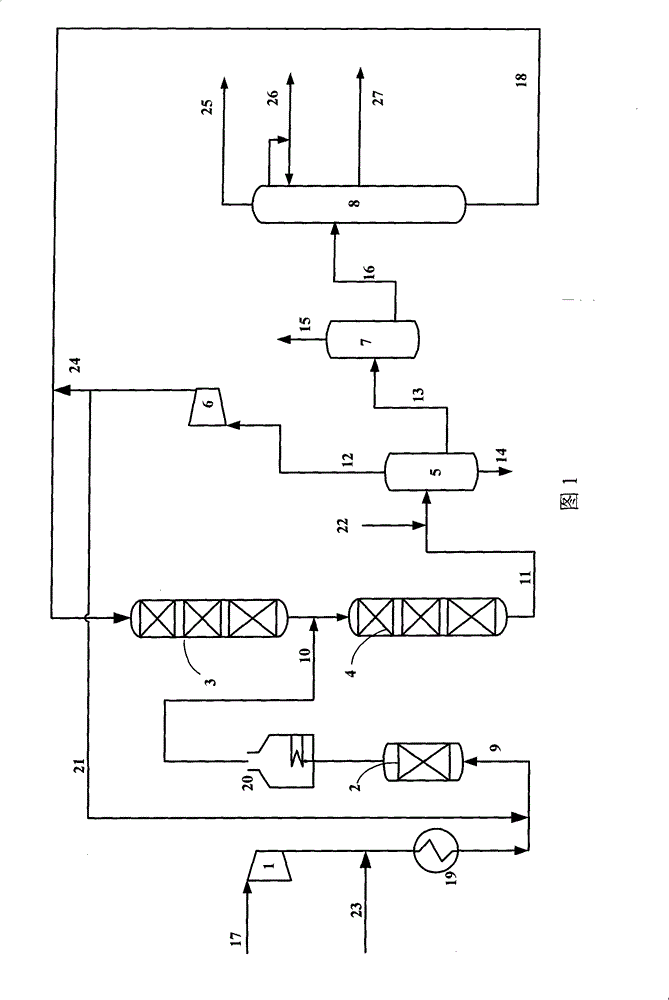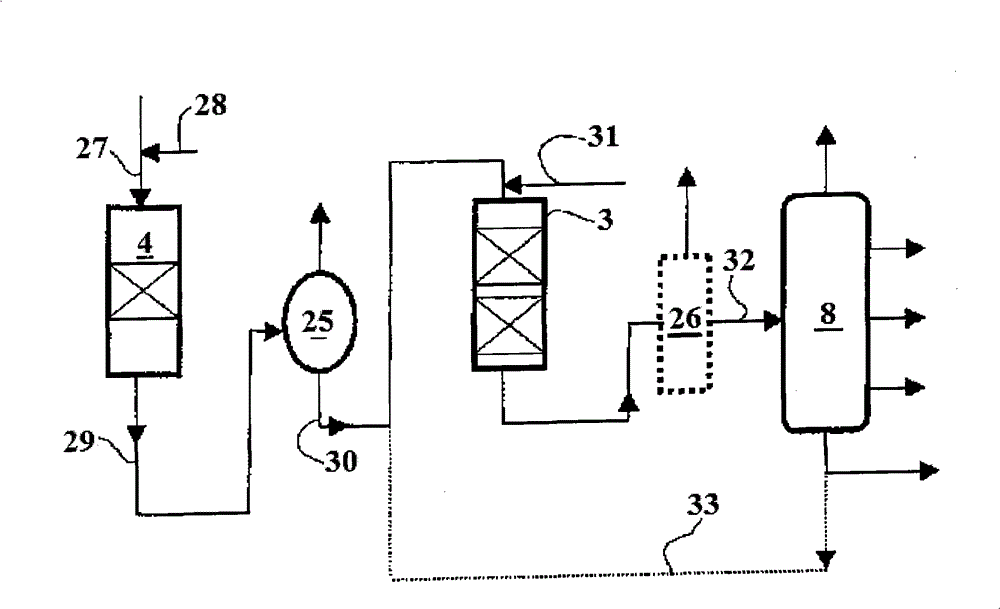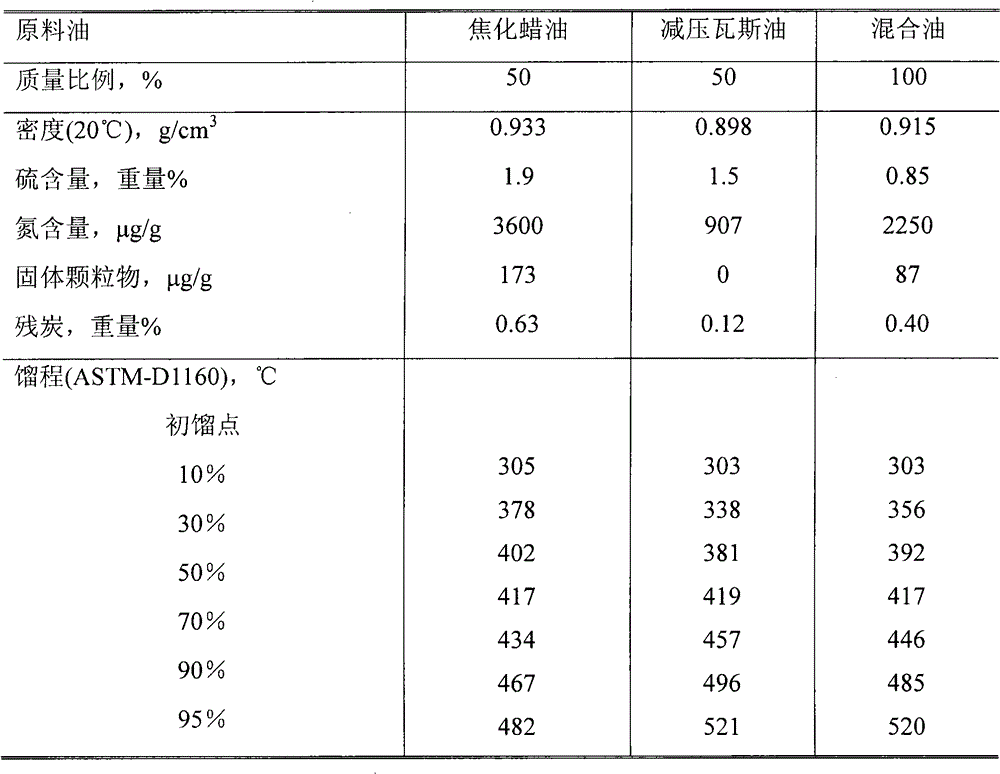Method for hydrocracking of coked wax oil
A technology of hydrocracking and coking wax oil, which is applied in the fields of hydrocarbon oil cracking and petroleum industry. It can solve the problems of the long-term operation of the device and the rapid rise of the pressure drop of the reactor, so as to facilitate the hydrocracking activity and prevent the bed The effect of increasing the pressure drop and reducing the dosage
- Summary
- Abstract
- Description
- Claims
- Application Information
AI Technical Summary
Problems solved by technology
Method used
Image
Examples
Embodiment 1
[0036] The feedstock oil is a mixture of 50% by weight of coker gas oil and 50% by weight of vacuum gas oil. The properties of the feedstock oil are shown in Table 1.
[0037] The catalyst used is that the hydrogenation protection catalyst loaded in the hydrogenation protection reactor is RG-1 catalyst, and the amount of loading is 33.3ml; the hydrofinishing catalyst loaded in the hydrofinishing reactor is RN-32 catalyst, and the loaded The amount is 200ml; the hydrocracking catalyst loaded in the hydrocracking reactor is RHC-1 catalyst, and the loaded amount is 100ml. The above-mentioned catalysts are all produced by Changling Catalyst Factory of Sinopec Catalyst Company.
[0038] The specific process is as follows:
[0039] Such as figure 1 As shown, the feedstock oil from pipeline 23 is mixed with the new hydrogen from pipeline 17 passing through the new hydrogen compressor 1, and after heat exchange in the heat exchanger 19, it is mixed with the circulating hydrogen from...
Embodiment 2
[0053] The feedstock oil is a mixture of 70% by weight of coker gas oil and 30% by weight of vacuum gas oil. The properties of the feedstock oil are shown in Table 5.
[0054] The adopted hydrogenation protection reactor, hydrofinishing reactor and hydrocracking reactor are the same as those in Example 1.
[0055] The catalyst used is that the hydrogenation protection catalyst loaded in the hydrogenation protection reactor is RG-1 catalyst, and the amount of loading is 26.7ml; the hydrofinishing catalyst loaded in the hydrofinishing reactor is RN-32 catalyst, and the loaded The amount is 200ml; the hydrocracking catalyst loaded in the hydrocracking reactor is RHC-1M catalyst, and the loaded amount is 80ml. The above-mentioned catalysts are all produced by Changling Catalyst Factory of Sinopec Catalyst Company.
[0056] The same process as in Example 1 was used to operate, except that the reaction conditions in each reactor were shown in Table 6, and the properties of the effl...
Embodiment 3
[0067]According to the raw material described in embodiment 1, catalyzer, process flow and reaction condition operate, difference is, what hydrogenation protection reactor adopted is fixed-bed reactor, and feeding mode is upper feeding, and the effluent of this reactor is from outflow from the bottom of the reactor.
[0068] After 5000 hours of continuous operation of the flow process, the pressure drop of the reactor bed rises, and subsequent operations cannot be performed. The properties of the final product at this time are shown in Table 9.
[0069] Compared with Example 1, the upper feeding mode of the hydrogenation protection reaction in Example 3 still makes the operation period of the whole device shorter.
[0070] Table 9
[0071]
PUM
 Login to View More
Login to View More Abstract
Description
Claims
Application Information
 Login to View More
Login to View More - R&D
- Intellectual Property
- Life Sciences
- Materials
- Tech Scout
- Unparalleled Data Quality
- Higher Quality Content
- 60% Fewer Hallucinations
Browse by: Latest US Patents, China's latest patents, Technical Efficacy Thesaurus, Application Domain, Technology Topic, Popular Technical Reports.
© 2025 PatSnap. All rights reserved.Legal|Privacy policy|Modern Slavery Act Transparency Statement|Sitemap|About US| Contact US: help@patsnap.com



